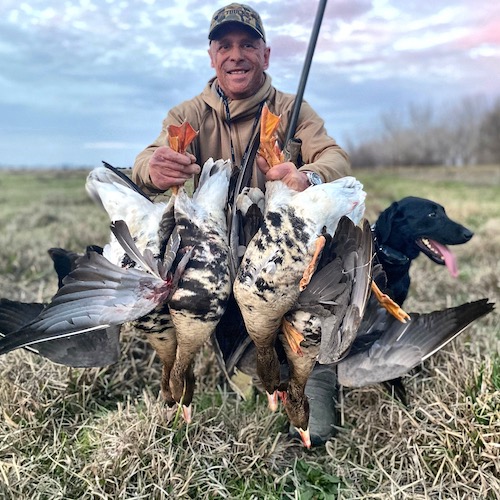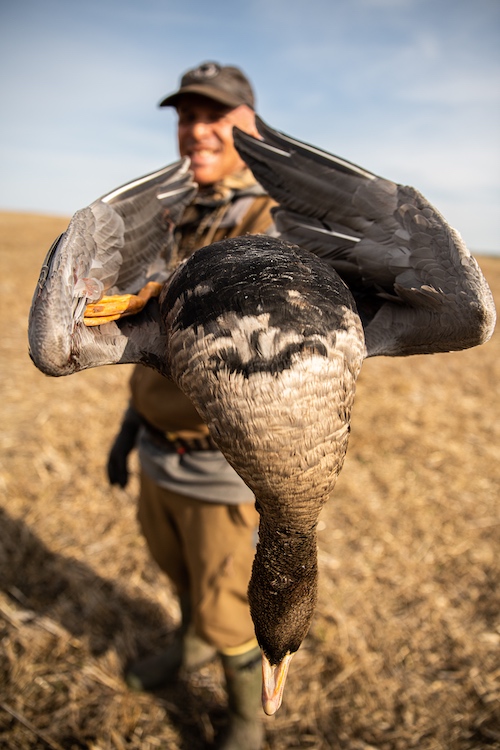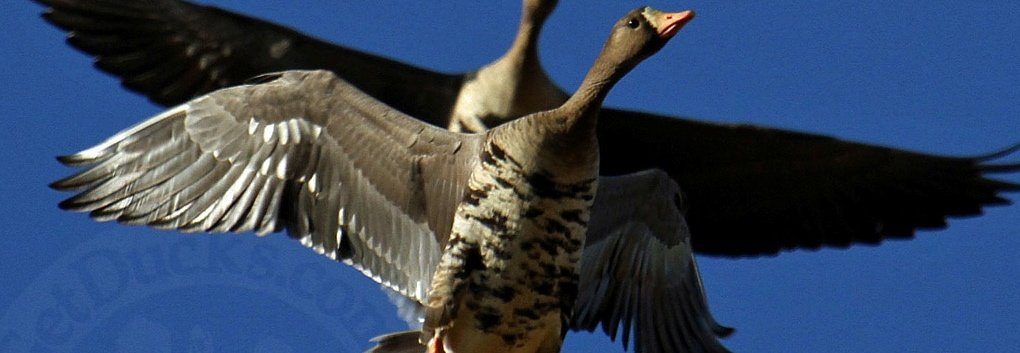White-fronted Goose
 The Greater White-fronted Goose (Anser albifrons) is widely nicknamed Specklebelly, or just Speck by hunters because of their characteristically black-mottled bellies. Other colloquial descriptions are bar-belly, tar-belly, laughing goose and giggle chicken. Both sexes of this medium-sized goose are similar in appearance with pinkish or orangish bills, distinctive white frontal facial patch, overall brown-gray body with distinctive white hindquarters, a white line at top of side pocket, naval orange-colored legs. Male white-fronted geese are only slightly larger than females and may normally have more prominent barring on the underbelly. Like the white frontal patch, the belly patchwork is individually variable. Mantle, scapulars and retrials medium gray-brown with pale feather fringes forming traverse barring. Juvenil White-fronted geese can be distinguished as lacking both the black mottling and the white facial plumage. In flight, the White-fronted Goose’s secondaries and entirety of the primaries are dark gray, and a white horseshoe-shaped patch can be seen above the tail feathers. White-fronted Geese are arguably the chattiest goose species. Their call, which they make in flight, sounds like klew yo-yo or leek-leek, and is described as a high-pitched laugh. Expert callers have described speckle bellies as having 9 distinct vocalizations. “You have to know what they’re talking about before interrupting the conversation,” described one southwest Louisiana call maker during a morning hunt before making them do back flips towards the decoys on hearing his first note.
The Greater White-fronted Goose (Anser albifrons) is widely nicknamed Specklebelly, or just Speck by hunters because of their characteristically black-mottled bellies. Other colloquial descriptions are bar-belly, tar-belly, laughing goose and giggle chicken. Both sexes of this medium-sized goose are similar in appearance with pinkish or orangish bills, distinctive white frontal facial patch, overall brown-gray body with distinctive white hindquarters, a white line at top of side pocket, naval orange-colored legs. Male white-fronted geese are only slightly larger than females and may normally have more prominent barring on the underbelly. Like the white frontal patch, the belly patchwork is individually variable. Mantle, scapulars and retrials medium gray-brown with pale feather fringes forming traverse barring. Juvenil White-fronted geese can be distinguished as lacking both the black mottling and the white facial plumage. In flight, the White-fronted Goose’s secondaries and entirety of the primaries are dark gray, and a white horseshoe-shaped patch can be seen above the tail feathers. White-fronted Geese are arguably the chattiest goose species. Their call, which they make in flight, sounds like klew yo-yo or leek-leek, and is described as a high-pitched laugh. Expert callers have described speckle bellies as having 9 distinct vocalizations. “You have to know what they’re talking about before interrupting the conversation,” described one southwest Louisiana call maker during a morning hunt before making them do back flips towards the decoys on hearing his first note.
Available Hunts
-
Alberta Canada Duck and Goose Hunt
Ranchland Outfitters best-of-best Alberta Canada Duck and goose hunting packages feature excellent waterfowl hunts, world-class food, unrivaled hospitality.
...read more- Inclusive Ranchland Outfitters package includes lodging and meals, professional guide services, scouting, ammo, hunting transfers, and bird processing.
- Choose either 3- or 6-day packages
- September through early November, and even into mid-December!
- Specializes in exclusive groups of 6-8, but smaller groups welcomed, too
- Millions acres stretching from boreal forest to US border
- Mallards, pintails, Canada geese, cackler geese, snow geese, white-fronted geese.
Rate: $3,750 hunter packages -
Arkansas Duck Hunting
Arkansas duck hunting camp experience on one of the state's most coveted properties. Location, location, location - smack in the middle of a 6,000- acre federal sanctuary, the area literally swarms with ducks daily.
...read more- Exclusive property surrounded by federal sanctuary holds many ducks for the entire Arkansas duck hunting season.
- Predominately mallards, pintail, gadwalls, green-wings and more
- Spacious, covered blind holds up 8-10 guns is very easily accessed with short, dry walk. Leave the waders at home!
- Large, deluxe 4-suite lodging
- Excellent home-cooked meals provided
- Located 30 minutes from Bastrop, 1 hour from Monroe, LA
- Corporate group rates
Rate: $650 day -
Missouri Duck Hunting
Missouri is usually where many mallards hang out until until hard water and snow cover finally drives drive them further south.
...read more- GREENHEADS, gadwalls, green-wings, pintails and specklebellies
- Rice, beans, flooded timber. Comfortable blinds.
- Inclusive 3-day packages include lodging, home-cooked meals, guided hunts
- NEW premium 9,000 square-foot lodge
- Perfect for 4-8 hunters.
- November through early January
Rate: $1,500 for 3-days -
North Dakota Waterfowl Hunt
Dirty Bird Outfitters delivers the best guided North Dakota waterfowl hunting experiences. North Dakota duck hunts, North Dakota goose hunts and North Dakota swan hunts are their specialties.
...read more- Guided North Dakota duck hunting combo packages
- High-success North Dakota Swan Hunts (must draw tag)
- Early- and late-season North Dakota Canada Goose Hunting
- Packages include meals and lodging
- NEW Home-away-from-home lodge (constructed 2021)
- Small, highly experienced and professional staff
- Mallards, wigeons, pintails, cackler geese, Canada geese, white-fronted geese, light geese, tundra swans
- Waterfowl hunting opportunities August through mid-December
Rate: $400-650 daily -
Saskatchewan Canada Goose and Duck Hunting
Northern Skies Outfitters - energetic staff is detailed oriented, proven experience delivering the classic prairie Canada waterfowl hunting adventures.
...read moreClassic, action-packed Saskatchewan Canada field hunting for geese and ducks in the Land of Living Skies!
- ALL-INCLUSIVE Choose from 3- to 6-days (or more)
- Excellent decoys and gear, professional guides and spotters
- Famous “Tiki Hut” Blind super comfortable
- Perfectly quaint lodge accommodations, home-cooked meals
- Canadas, cacklers, light geese, specks, mallards, pintails
- Solo hunters accepted; 11-hunters minimum exclusive group
- Thousands square-miles of hunting area well off beaten path
Rate: $2,975 (3-day) -
Saskatchewan Canada Waterfowl Hunts
Prairie Limits Outfitters delivers superior Saskatchewan Canada waterfowl hunts in "The land of Living Skies."
...read moreDelivering consistently great Saskatchewan Canada waterfowl hunts is what Prairie Limits Outfitters does. Young energetic staff of go-getters are highly experienced.
- Mostly dry-field hunts for Canadas, cacklers, white-fronts, snows, mallards and pintails, sandhill cranes
- Choose between 3- or 5-day waterfowl hunting packages
- INCLUSIVE packages, choose either Fully Guided or Premier hunting experiences
- New lodge conveniently located to community amenities
- Fly into either Saskatoon SK or Edmonton AB
Rate: $2,800 and up -
Texas Duck Hunting – Gulf Coast Redheads and More
Run-N-Gun Adventures accesses the greatest percentage of the entire world’s population of overwintering redheads on nearby Laguna Madre and surrounding areas for the Texas duck hunting experience of a lifetime. But LOTS more, too.
...read more- Trophy Redheads on Matagorda Bay
- Pintail, teal, mottled ducks, black-bellied whistlers, white-fronts, snows and more
- 50,000+ acres exclusive, intensively managed properties
- Cast & Blast packages and afternoon hunts available
- NEW 11,000 sqft luxurious lodge, chef-prepared meals
- Located only 1 hour from Houston
Rate: $175-300 day rate/ $1,425 and up packages -
Texas Waterfowl Hunt – Desert Paradise
Texas waterfowl hunt packages features relatively unpressured ducks, geese and sandhill cranes in an area so large it takes 3 lodges to cover and so ecologically diverse that most Central Flyway waterfowl species can be hunted!
...read more- Inclusive Texas waterfowl hunting packages for ducks, geese, sandhill cranes, doves, early blue-winged teal, spring turkeys, more.
- 3 lodges to cover vast, relatively undisturbed waterfowl hunting area and to offer flexibility for desired bucket-list species, amenity-level needs, or personal budget
- Central flyway puddle ducks to include prized mottled duck, Mexican duck, cinnamon teal, fulvous whistling duck, black-bellied whistling duck opportunities all right here in USA
- Sandhill crane hunting and white-fronted goose hunting are the Speck Ops Waterfowl house specialties
- Luxurious lodging with over-the-top and fun activities provide fun for bachelor or business hunting groups, entire families and non-hunters,
Rate: $2,000 to $2,900
 North America’s Greater White-fronted Goose (A. a. gambelli, frontalis and sponsa) breeds in the arctic tundra. Several distinct breeding colonies are recognized, with the majority found in western and northern Alaska, the northern Yukon, and northern Nunavut. Of this, there are mid-continual and Pacific Flyway populations. Interestingly, most mid-continental white-fronts funnel into a narrow river valley between Alberta and Saskatchewan to stage.
North America’s Greater White-fronted Goose (A. a. gambelli, frontalis and sponsa) breeds in the arctic tundra. Several distinct breeding colonies are recognized, with the majority found in western and northern Alaska, the northern Yukon, and northern Nunavut. Of this, there are mid-continual and Pacific Flyway populations. Interestingly, most mid-continental white-fronts funnel into a narrow river valley between Alberta and Saskatchewan to stage.
Female specklebellies choose the nesting sites on the ground the in dense vegetation of shrubs, grasses, or sedges, typically on wetter soils. White-fronted geese are monogamous. remaining with their mates for life. Summer diet is dominated by plants such as sedges, grasses, and berries, while the winter diet consists of grains and seeds. Both emergent and submerged plants will be consumed. The mates and occasionally their young will migrate together. Specklebellies young will stop migrating with their parents when they reach the breeding age of ~2.5 years. This species, despite high territoriality during the breeding season, are very social and winter in large flocks in California, Arkansas, Louisiana, Texas, and down along the Gulf Coast of Mexico.
During the past couple decades, both Pacific Flyway and mid-continental populations of White-fronted Geese have exploded, but the wintering distribution of mid-continental white-fronts have changed. As many as 80% of Greater White-fronted geese historically overwintered in southwest Louisiana, but now much fewer do. Many speckle bellied geese may continue migrating to southwest Louisiana, but soon bounce back north, into places like Arkansas. Abundant agriculture further up the flyway, combined with a changed landscape in Louisiana to include sugar-cane fields, commercial crawfish ponds and marsh deterioration, may contribute to specklebelly distribution shifts.
Learn more. Listen to Duck Season Somewhere Podcast episode: Specklebellies in Louisiana
TAR BELLY. SPECKLEBELLY. WHITE-FRONTED GOOSE. Historically short-grass prairie, the region is now predominately agriculture. Wheat, barley, oats, feed peas for as far as you can see in all directions. Listening to white-fronts’ incessantly melodious yodeling in the ink blue darkness before legal, I wonder how many more – or fewer – geese utilized the area back when it was native prairie grass instead of all-you-can-eat grain. It seems warm for goose hunting, but their biological migratory clocks are triggered by decreased daylight length. First the adult non-breeding white-fronts, followed soon by breeding birds and their offspring. And by around mid-October they’re gone. Southward bound. Geographical features are such that a majority of specklebellies funneling through an area I’d guesstimate about 350 miles wide, fanning throughout the Mississippi, Central and likely Pacific flyways after they get south of Canada.







